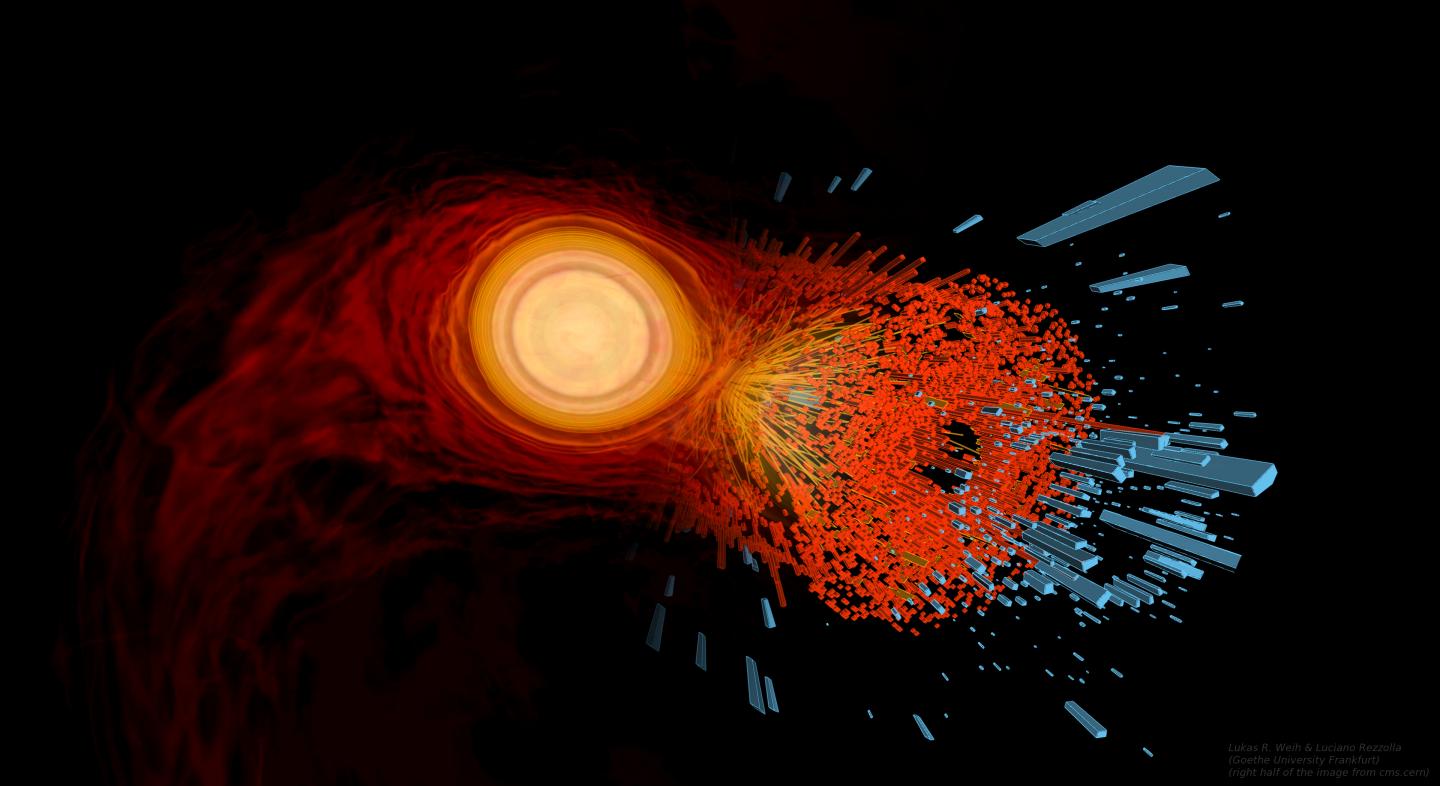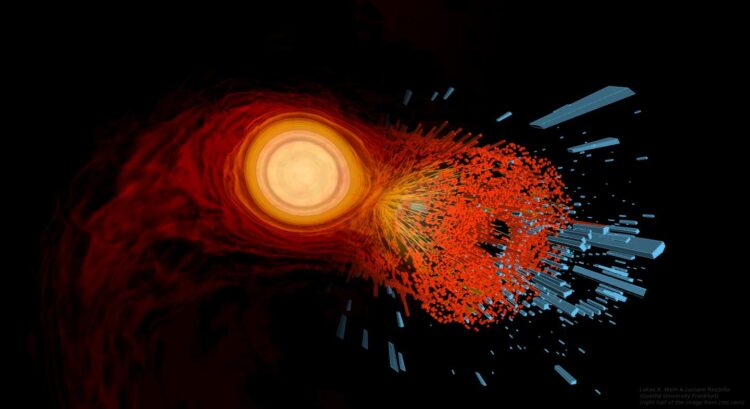Computer models of merging neutron stars predicts how to tell when this happens

Credit: Lukas R. Weih & Luciano Rezzolla (Goethe University Frankfurt) (right half of the image from cms.cern)
Neutron stars are among the densest objects in the universe. If our Sun, with its radius of 700,000 kilometres were a neutron star, its mass would be condensed into an almost perfect sphere with a radius of around 12 kilometres. When two neutron stars collide and merge into a hyper-massive neutron star, the matter in the core of the new object becomes incredibly hot and dense. According to physical calculations, these conditions could result in hadrons such as neutrons and protons, which are the particles normally found in our daily experience, dissolving into their components of quarks and gluons and thus producing a quark-gluon plasma.
In 2017 it was discovered for the first time that merging neutron stars send out a gravitational wave signal that can be detected on Earth. The signal not only provides information on the nature of gravity, but also on the behaviour of matter under extreme conditions. When these gravitational waves were first discovered in 2017, however, they were not recorded beyond the merging point.
This is where the work of the Frankfurt physicists begins. They simulated merging neutron stars and the product of the merger to explore the conditions under which a transition from hadrons to a quark-gluon plasma would take place and how this would affect the corresponding gravitational wave. The result: in a specific, late phase of the life of the merged object a phase transition to the quark-gluon plasma took place and left a clear and characteristic signature on the gravitational-wave signal.
Professor Luciano Rezzolla from Goethe University is convinced: “Compared to previous simulations, we have discovered a new signature in the gravitational waves that is significantly clearer to detect. If this signature occurs in the gravitational waves that we will receive from future neutron-star mergers, we would have a clear evidence for the creation of quark-gluon plasma in the present universe.”
###
Publication: Post-merger gravitational wave signatures of phase transitions in binary mergers
Lukas R. Weih, Matthias Hanauske, Luciano Rezzolla, Physical Review Letters DOI 10.1103/PhysRevLett.124.171103 https:/
Video: Visualisation of merging neutron stars: https:/
This simulation shows the density of the ordinary matter (mostly neutrons) in red-yellow. Shortly after the two stars merge the extremely dense centre turns green, depicting the formation of the quark-gluon plasma.
Pictures may be downloaded here: http://www.
Caption Montage: Montage of the computer simulation of two merging neutron stars that blends over with an image from heavy-ion collisions to highlight the connection of astrophysics with nuclear physics. Credit: Lukas R. Weih & Luciano Rezzolla (Goethe University Frankfurt) (right half of the image from cms.cern)
Caption Simulation: Shortly after two neutron stars merge a quark gluon plasma forms in the centre of the new object. Red yellow: ordinary matter, mostly neutrons. Credit: Lukas R. Weih & Luciano Rezzolla (Goethe University Frankfurt)
Further information:
Goethe University Frankfurt
Prof. Dr. Luciano Rezzolla
Chair of Theoretical Astrophysics
Institute for Theoretical Physics
+49-69-79847871/47879
[email protected]
https:/
Current news about science, teaching, and society can be found on GOETHE-UNI online (http://www.
Goethe University is a research-oriented university in the European financial centre Frankfurt am Main. The university was founded in 1914 through private funding, primarily from Jewish sponsors, and has since produced pioneering achievements in the areas of social sciences, sociology and economics, medicine, quantum physics, brain research, and labour law. It gained a unique level of autonomy on 1 January 2008 by returning to its historic roots as a “foundation university”. Today, it is one of the three largest universities in Germany. Together with the Technical University of Darmstadt and the University of Mainz, it is a partner in the inter-state strategic Rhine-Main University Alliance. Internet: http://www.
Publisher: The President of Goethe University Editor: Dr. Markus Bernards, Science Editor, PR & Communication Department, Theodor-W.-Adorno-Platz 1, 60323 Frankfurt am Main, Tel: -49 (0) 69 798-12498, Fax: +49 (0) 69 798-763 12531, [email protected].
Media Contact
Luciano Rezzolla
[email protected]
Related Journal Article
http://dx.





